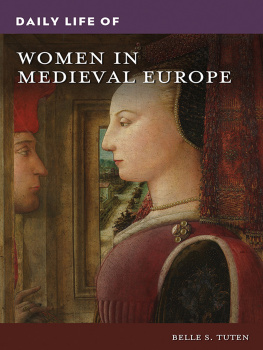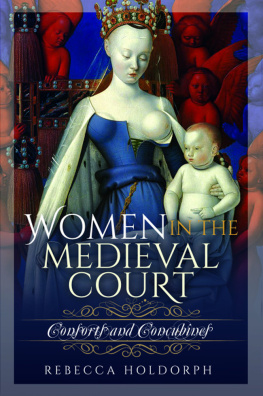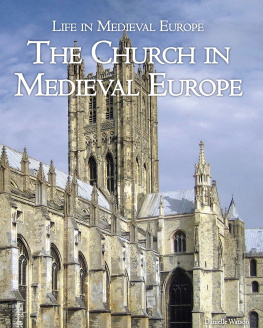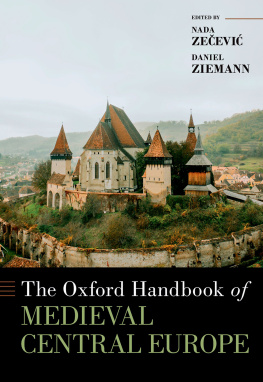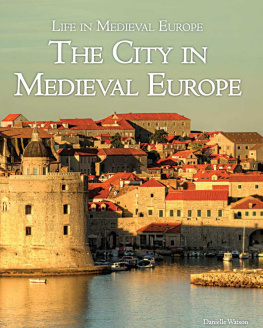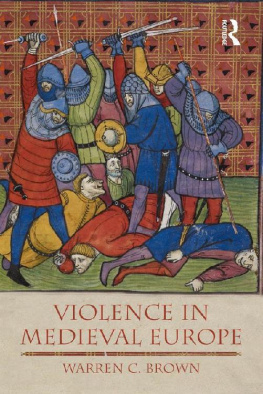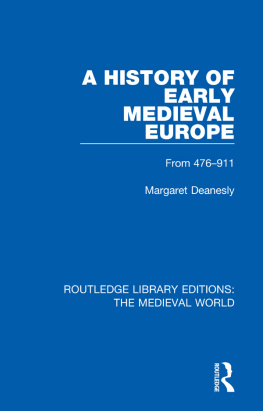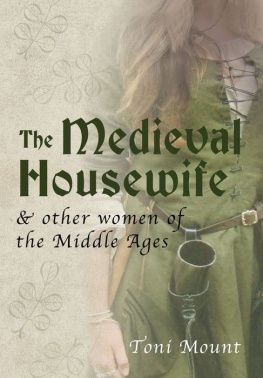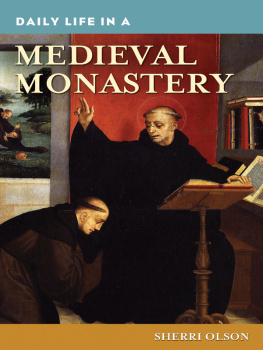Belle S. Tuten - Daily Life of Women in Medieval Europe
Here you can read online Belle S. Tuten - Daily Life of Women in Medieval Europe full text of the book (entire story) in english for free. Download pdf and epub, get meaning, cover and reviews about this ebook. year: 2022, publisher: ABC-CLIO, genre: Home and family. Description of the work, (preface) as well as reviews are available. Best literature library LitArk.com created for fans of good reading and offers a wide selection of genres:
Romance novel
Science fiction
Adventure
Detective
Science
History
Home and family
Prose
Art
Politics
Computer
Non-fiction
Religion
Business
Children
Humor
Choose a favorite category and find really read worthwhile books. Enjoy immersion in the world of imagination, feel the emotions of the characters or learn something new for yourself, make an fascinating discovery.
- Book:Daily Life of Women in Medieval Europe
- Author:
- Publisher:ABC-CLIO
- Genre:
- Year:2022
- Rating:4 / 5
- Favourites:Add to favourites
- Your mark:
- 80
- 1
- 2
- 3
- 4
- 5
Daily Life of Women in Medieval Europe: summary, description and annotation
We offer to read an annotation, description, summary or preface (depends on what the author of the book "Daily Life of Women in Medieval Europe" wrote himself). If you haven't found the necessary information about the book — write in the comments, we will try to find it.
Daily Life of Women in Medieval Europe — read online for free the complete book (whole text) full work
Below is the text of the book, divided by pages. System saving the place of the last page read, allows you to conveniently read the book "Daily Life of Women in Medieval Europe" online for free, without having to search again every time where you left off. Put a bookmark, and you can go to the page where you finished reading at any time.
Font size:
Interval:
Bookmark:

DAILY LIFE OF
WOMEN IN
MEDIEVAL
EUROPE
Recent Titles in
The Greenwood Press Daily Life Through History Series
Colonial New England, Second Edition
Claudia Durst Johnson
Life in 1950s America
Nancy Hendricks
Jazz Age America
Steven L. Piott
Women in the Progressive Era
Kirstin Olsen
The Industrial United States, 18701900, Second Edition
Julie Husband and Jim OLoughlin
The 1960s Counterculture
Jim Willis
Renaissance Italy, Second Edition
Elizabeth S. Cohen and Thomas V. Cohen
Nazi-Occupied Europe
Harold J. Goldberg
African American Slaves in the Antebellum
Paul E. Teed and Melissa Ladd Teed
Women in Postwar America
Nancy Hendricks
Women in Ancient Egypt
Lisa K. Sabbahy
Women in Ancient Rome
Sara Phang
Women in Chaucers England
Jennifer C. Edwards
Anglo-Saxon England
Sally Crawford
The American West
Jason E. Pierce
DAILY LIFE OF
WOMEN IN
MEDIEVAL
EUROPE
BELLE S. TUTEN
The Greenwood Press Daily Life Through History Series

Copyright 2022 by ABC-CLIO, LLC
All rights reserved. No part of this publication may be reproduced, stored in a retrieval system, or transmitted, in any form or by any means, electronic, mechanical, photocopying, recording, or otherwise, except for the inclusion of brief quotations in a review, without prior permission in writing from the publisher.
Library of Congress Cataloging-in-Publication Data
Names: Tuten, Belle S., author.
Title: Daily life of women in Medieval Europe / Belle S. Tuten.
Description: Santa Barbara, California : Greenwood, [2022] | Series: The Greenwood Press daily life through history series | Includes bibliographical references and index.
Identifiers: LCCN 2022026259 | ISBN 9781440872341 (hardcover) | ISBN 9781440872358 (ebook)
Subjects: LCSH: WomenEuropeHistoryMiddle Ages, 5001500. | WomenEuropeSocial conditions. | WomenEuropeSocial life and customs. | WomenPolitical activityEuropeHistoryTo 1500.
Classification: LCC HQ1147.E85 T87 2022 | DDC 305.420940902dc23/eng/20220622
LC record available at https://lccn.loc.gov/2022026259
ISBN: 978-1-4408-7234-1 (print)
978-1-4408-7235-8 (ebook)
262524232212345
This book is also available as an eBook.
Greenwood
An Imprint of ABC-CLIO, LLC
ABC-CLIO, LLC
147 Castilian Drive
Santa Barbara, California 93117
www.abc-clio.com
This book is printed on acid-free paper 
Manufactured in the United States of America
CONTENTS
Women make up approximately half the population in every human society, but sources to explore their experiences in the distant past are not abundant when compared to sources by and about men. When we think about women in the Middle Ages from our vantage point in the twenty-first century, we fill in what we dont know with our imaginations. Our imaginations provide us with both horrors and fantasies; its sometimes hard to separate our fictional views of knights and ladies from our ideas about the real dangers, filth, and hardships of everyday medieval life. This book attempts to clarify what we know and what we do not know about womens daily lives in the Western European Middle Ages, between approximately 500 and 1500 CE.
It is important to realize that people of the time never called themselves medieval or called their era the Middle Ages. Scholars in the fourteenth and fifteenth centuries invented the term, which comes from the Latin words medium aevum, the middle age. They wanted to distinguish themselves from what they saw as the backward and violent dark ages in between the Roman Empire and their own time. This viewpoint has persisted into our own era. Calling something medieval todaya technology, a person, or a point of viewis not a compliment. We imagine medieval women as oppressed and miserable, locked into drudgery, constant pregnancy, and domestic abuse. However, this book will show that women in the Middle Ages, although significantly different from us, had experiences that are familiar to us today: living good lives, working within economic systems, bearing and raising families, and contributing to the larger culture of the period. This book is arranged topically, but the topics are mainly organized chronologically. There is also a timeline of major moments in medieval womens history and a bibliography of secondary sources. Boldface terms in the text are included in the Glossary at the end of the book.
The introduction provides some basics about the Middle Agesa quick review of the history, trends, and events of the period. This chapter also discusses some long-standing stereotypes about the Middle Ages, particularly with regard to life span, hygiene, and cultural values. We pick up with two of the issues most pertinent to medieval societys understanding of women in survive. This chapter ends with five primary document excerpts of these womens works.
I would like to acknowledge debts of gratitude to my colleagues in the Department of Art and Art History at Juniata College and my readers, Jim Tuten, Tom Stoddard, Madison Caso, and Mara Revitsky. I dedicate this book to my mother.
This book explores womens daily experiences in the European Middle Ages, a period that lasted about a thousand years. Scholars generally divide the Middle Ages into three periods: the early Middle Ages, lasting from the year 500 CE to the year 1000; the High Middle Ages, from 1000 to 1300; and the late Middle Ages, 1300 to 1500. These dates are approximate, and we use them chiefly to help us understand a long and complex period. The Middle Ages took shape when the western Roman Empire declined in power and organization, during the period of roughly 200500 CE. In 476 CE, a Germanic king deposed the Roman emperor in the west, while the Byzantine empire, centered in Constantinople, endured. The map of western Europe was broken up into kingdoms based on various Germanic groups. For conveniences sake, scholars sometimes use 476 CE as the beginning point for the Middle Ages in the west, but the process was gradual and took several centuries.
The conflicts of the fourth and fifth centuries CEsome of purely Roman origin and some involving migrating Germanic tribeshad left the populations of western Europe diminished and Roman control greatly lessened. The three major successors of the Roman Empire in the west were the kingdoms of Gaul, Italy, and Spain, each ruled by a different Germanic ethnic group: Gaul (France) by the Franks, Italy by the Ostrogoths, and Spain by the Visigoths. Over time, each Germanic group succeeded in making political and social connections with the Roman populations of the lands they occupied and gradually converted to Roman Catholic Christianity. The societies they created, just like the Roman societies before them, were centered on agriculture. Royal power was weak. Latin survived as the language of the highly educated, particularly those in the church, and it eventually became the language of Christian religious ritual. Everyday spoken Latin also contributed to the development of what we call Romance languages, such as French, Spanish, and Italian (Tierney 1999, 7172).
The Franks, under King Clovis (ca. 466511), were traditionally the first Germanic people to convert to Roman Catholic Christianity and the first to succeed in a major expansion. Frankish expansion allowed for a kingdom with imperial ambitions. Under the Frankish king Charles the Great, or Charlemagne (ca. 742814), the Franks entered an important relationship with the popes in Rome that enabled their kings to claim the title of Roman emperor. The time of Charlemagne has sometimes been called the Carolingian
Font size:
Interval:
Bookmark:
Similar books «Daily Life of Women in Medieval Europe»
Look at similar books to Daily Life of Women in Medieval Europe. We have selected literature similar in name and meaning in the hope of providing readers with more options to find new, interesting, not yet read works.
Discussion, reviews of the book Daily Life of Women in Medieval Europe and just readers' own opinions. Leave your comments, write what you think about the work, its meaning or the main characters. Specify what exactly you liked and what you didn't like, and why you think so.

